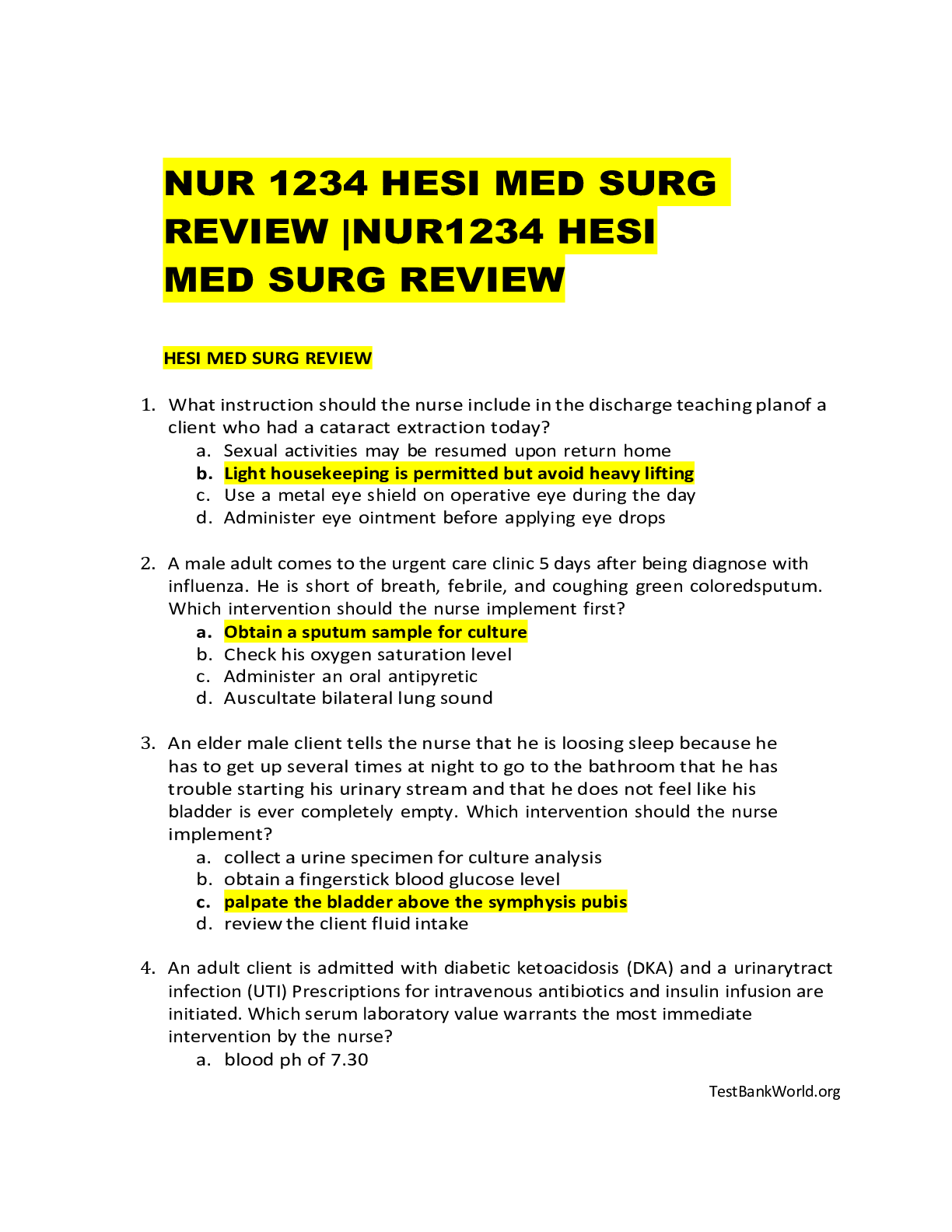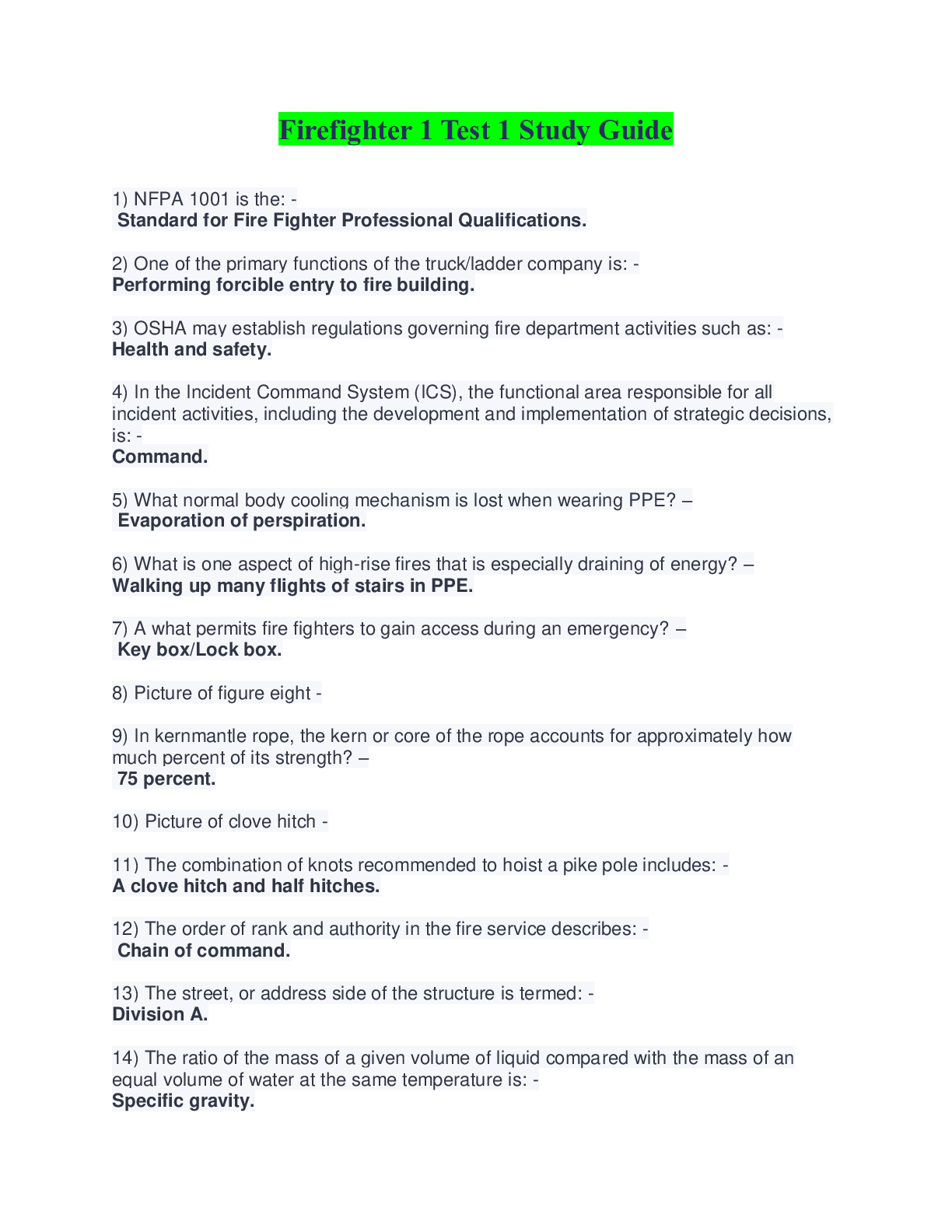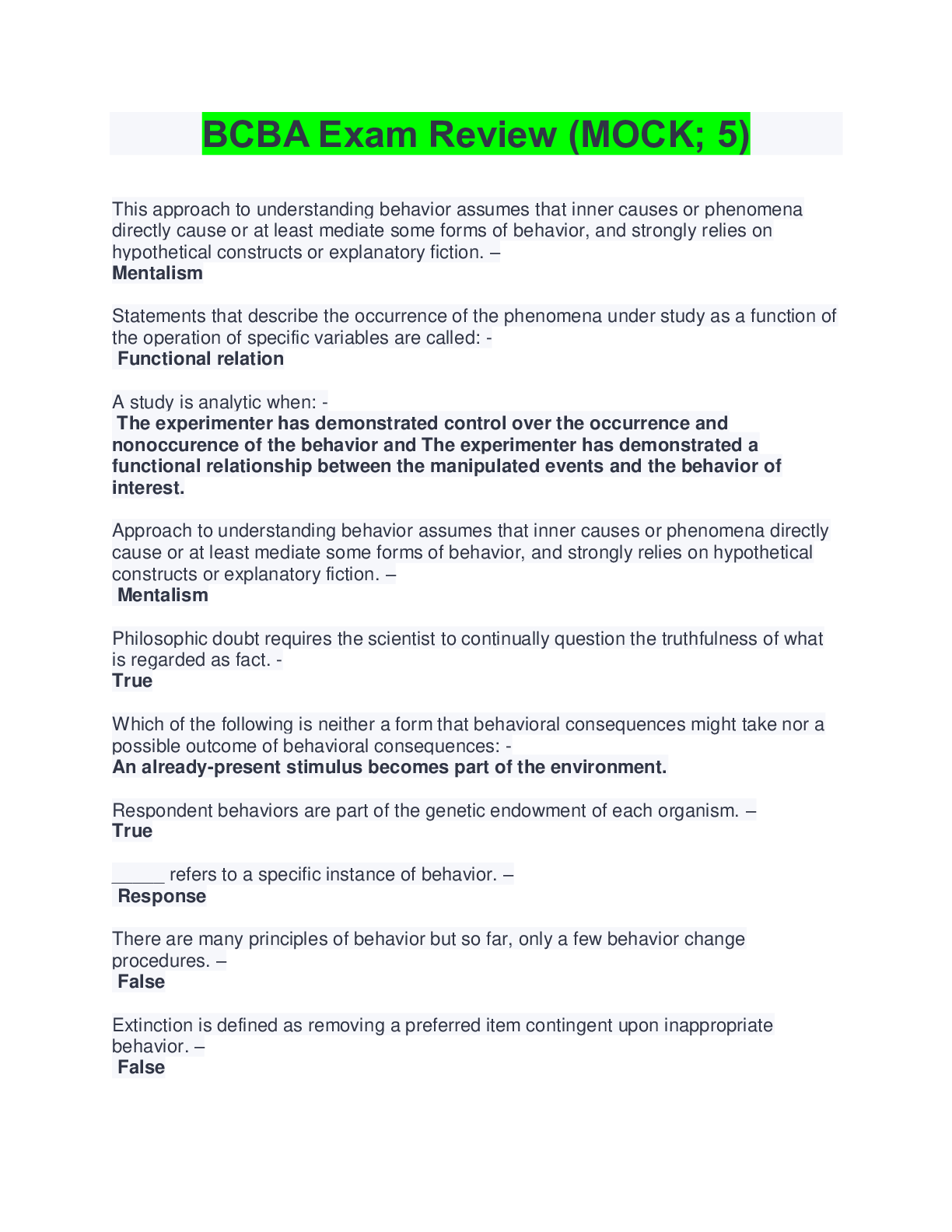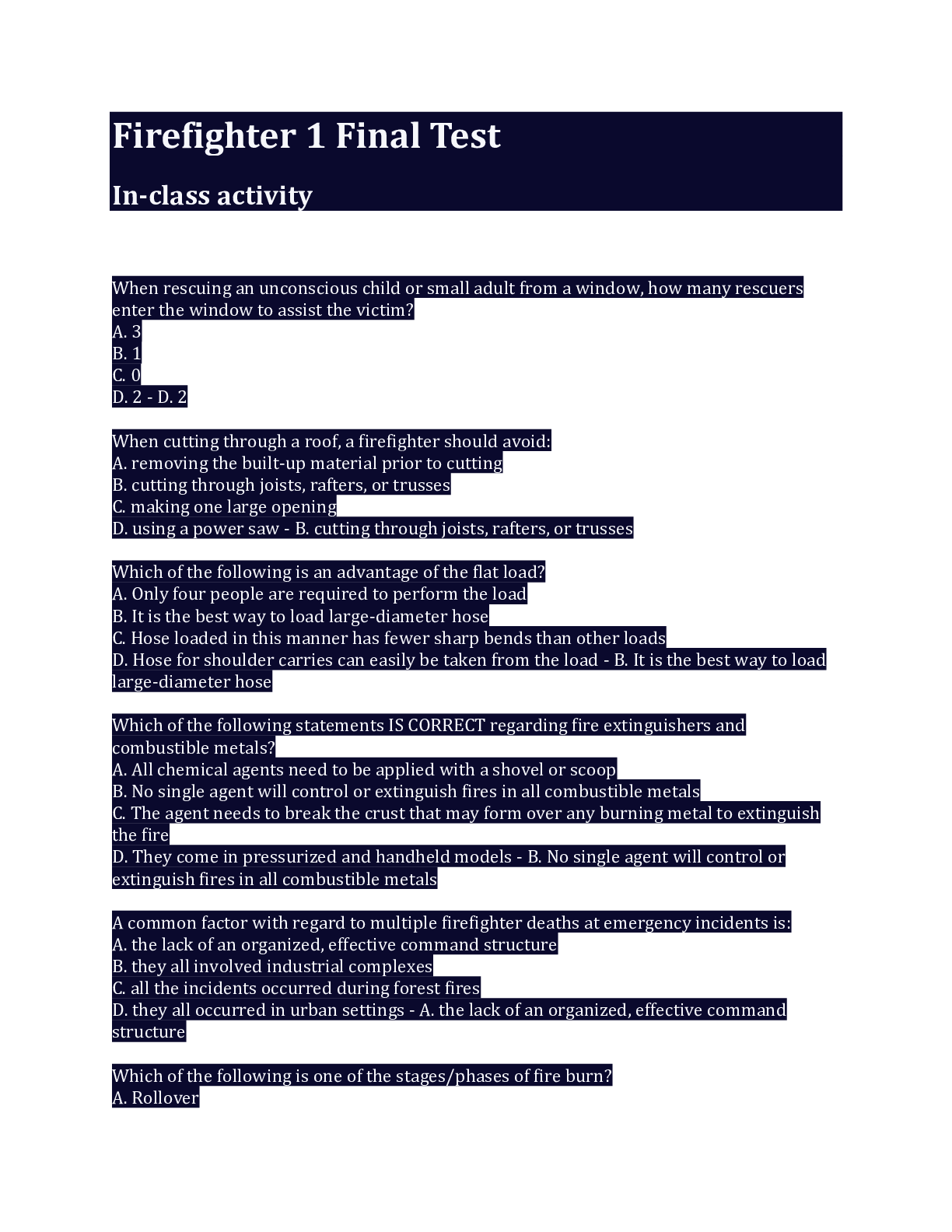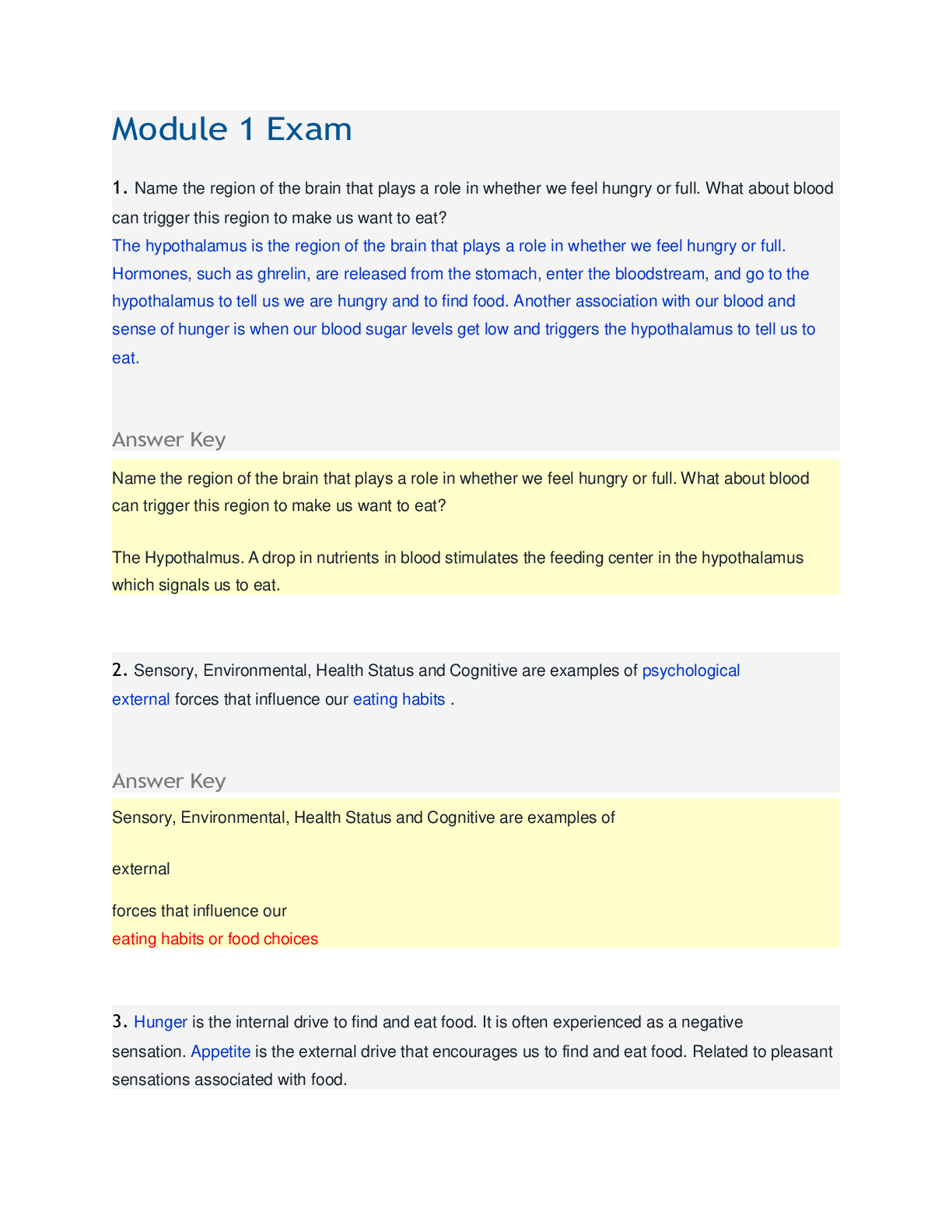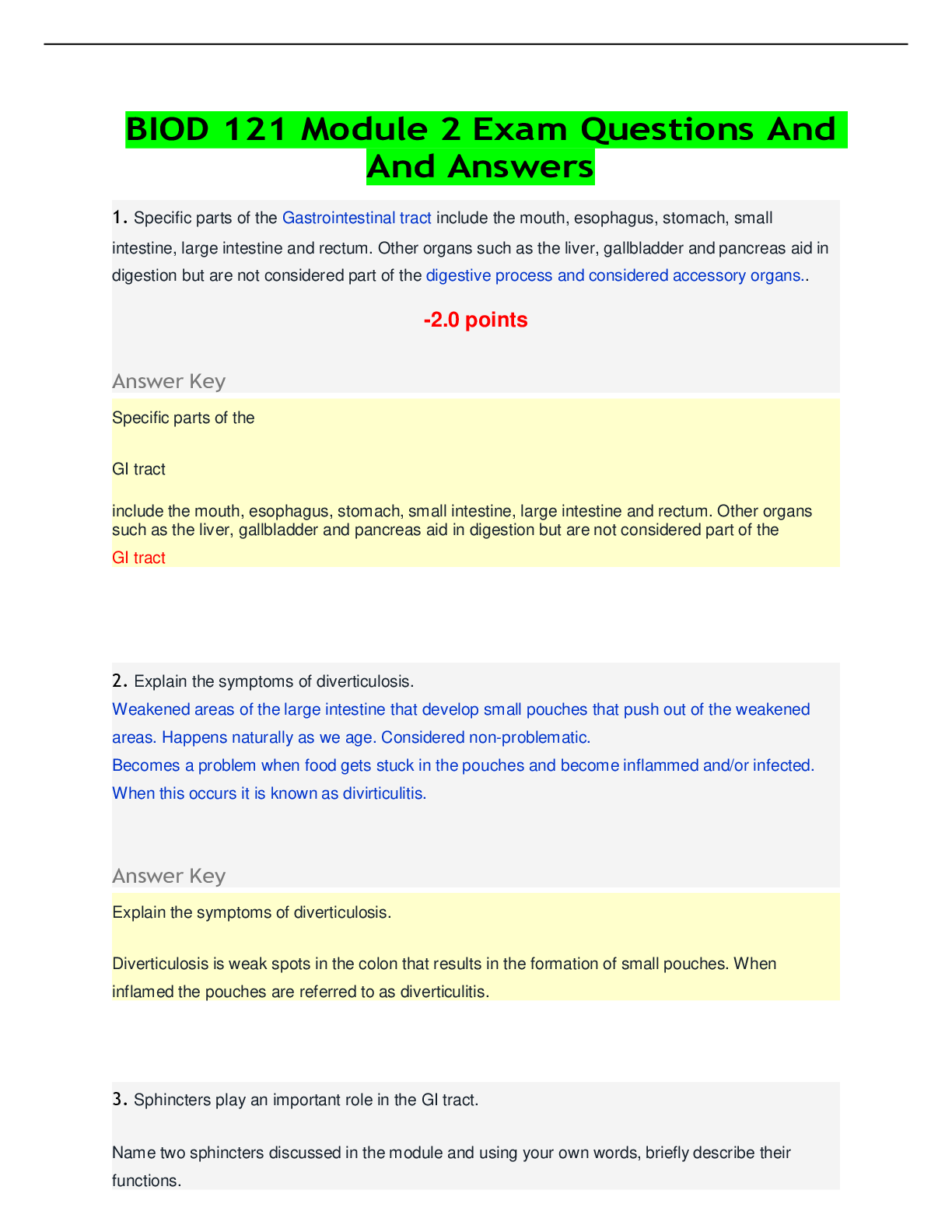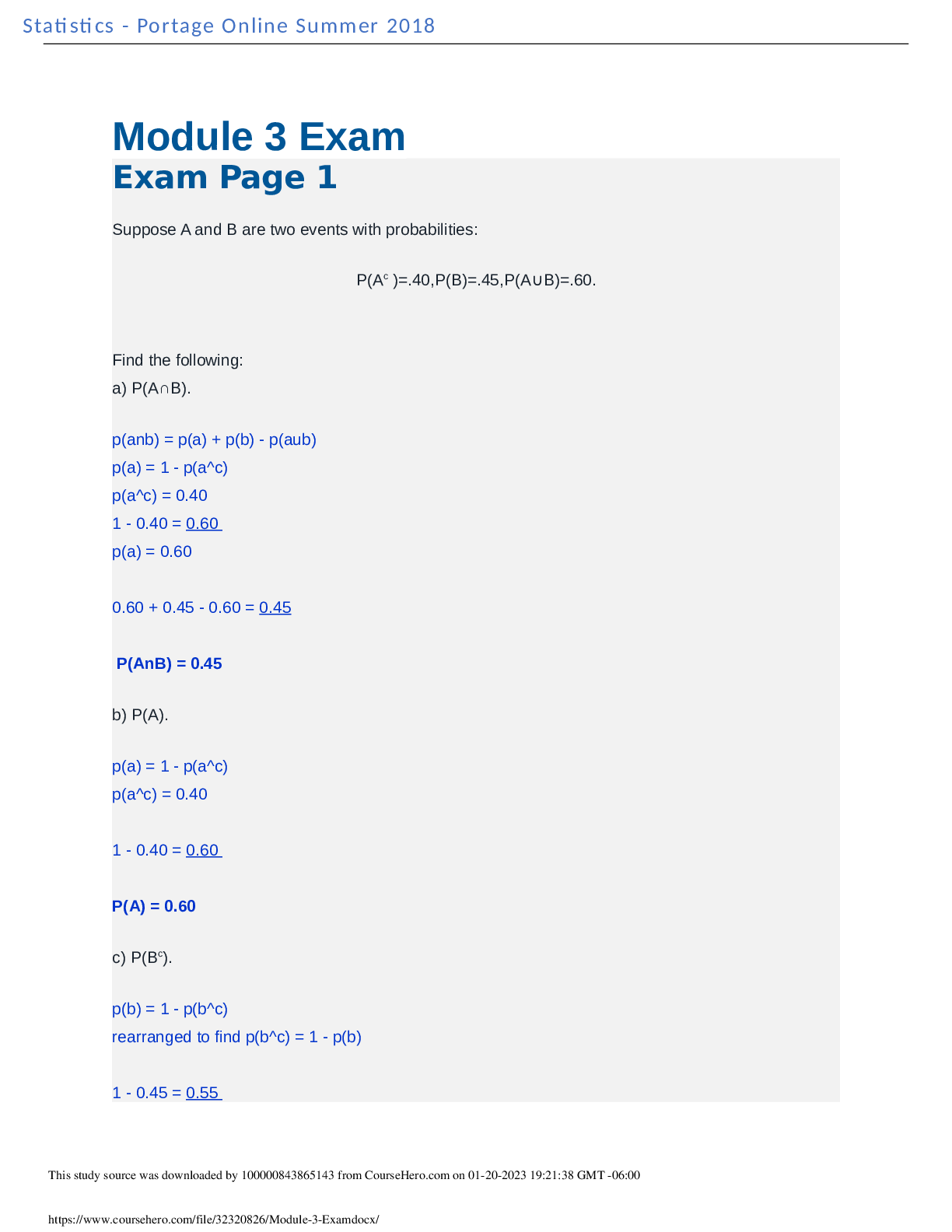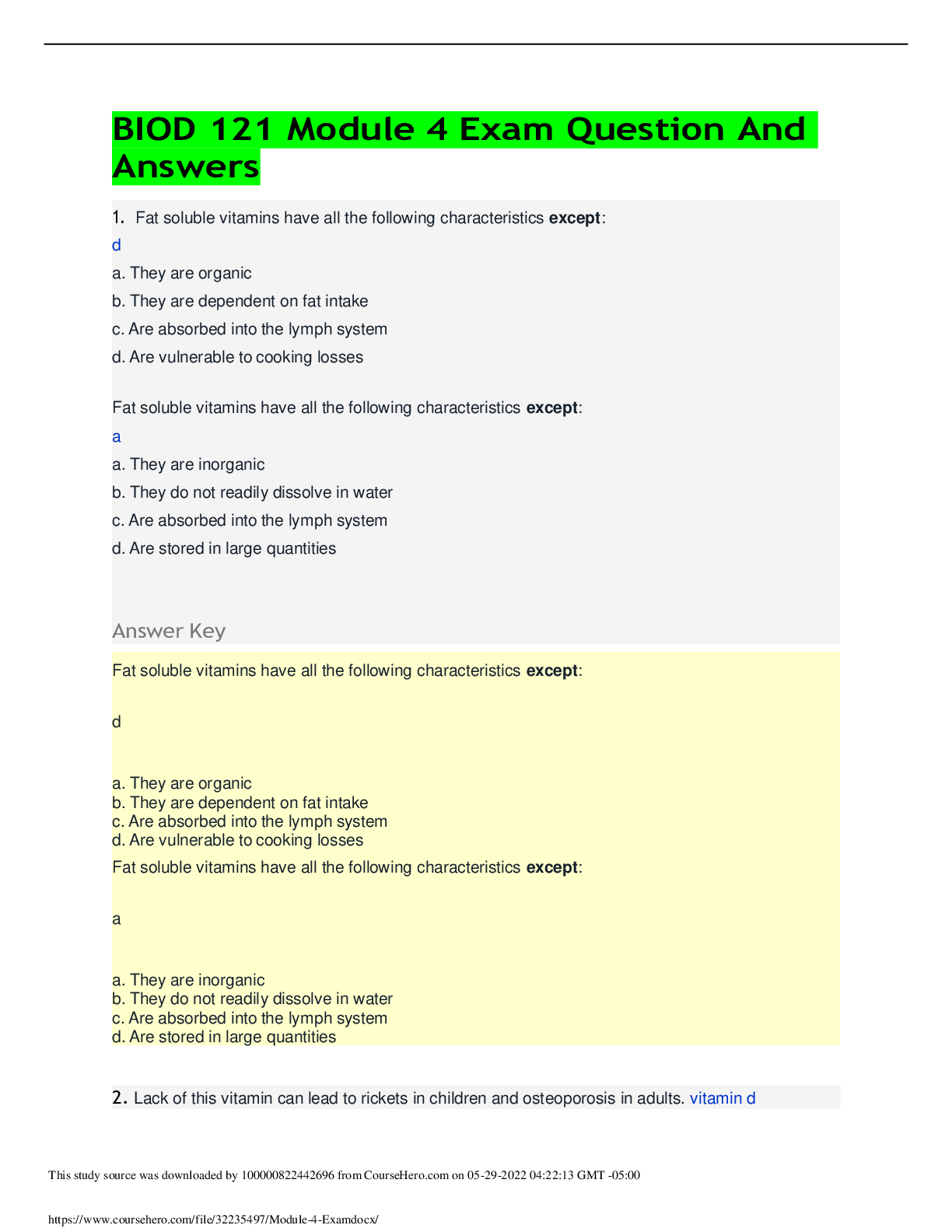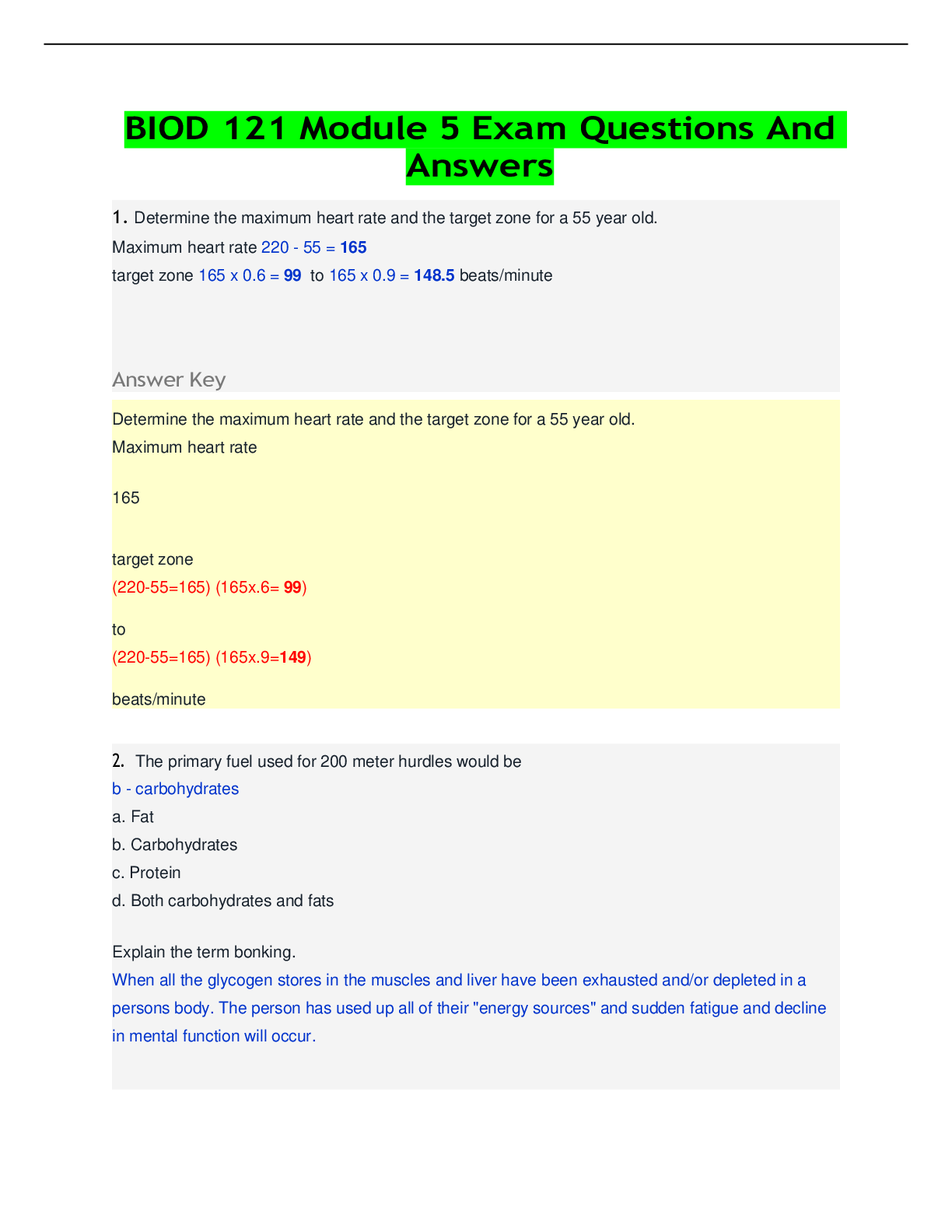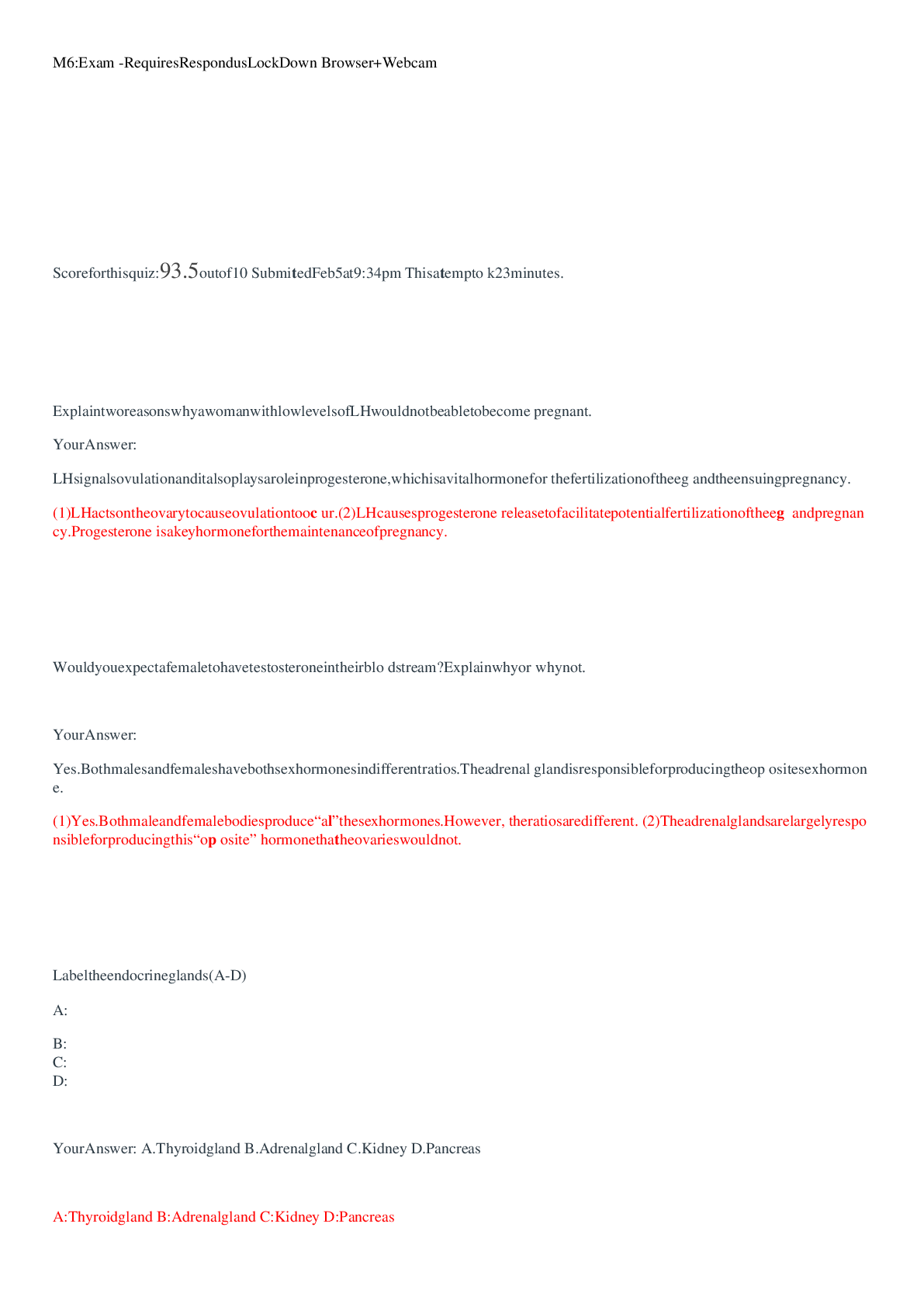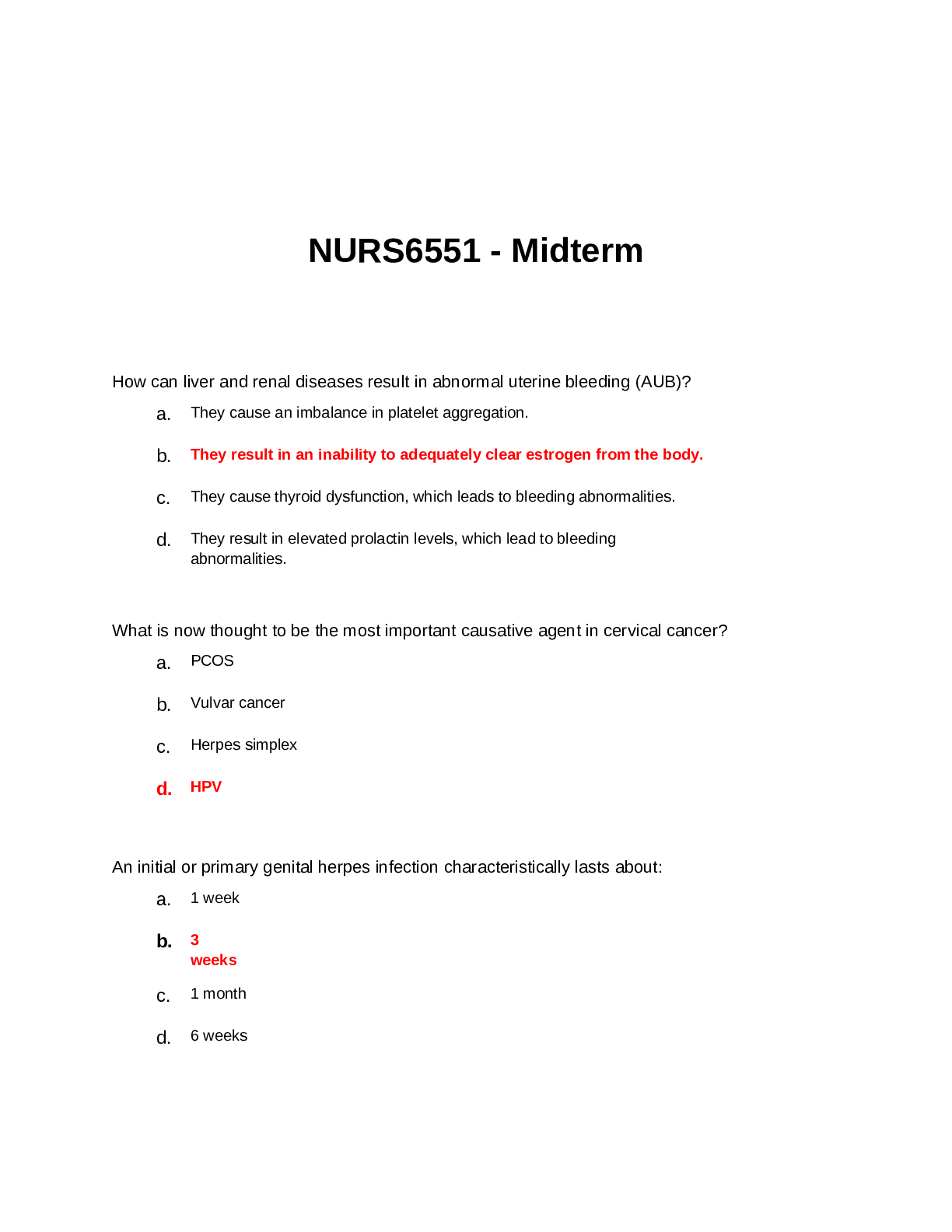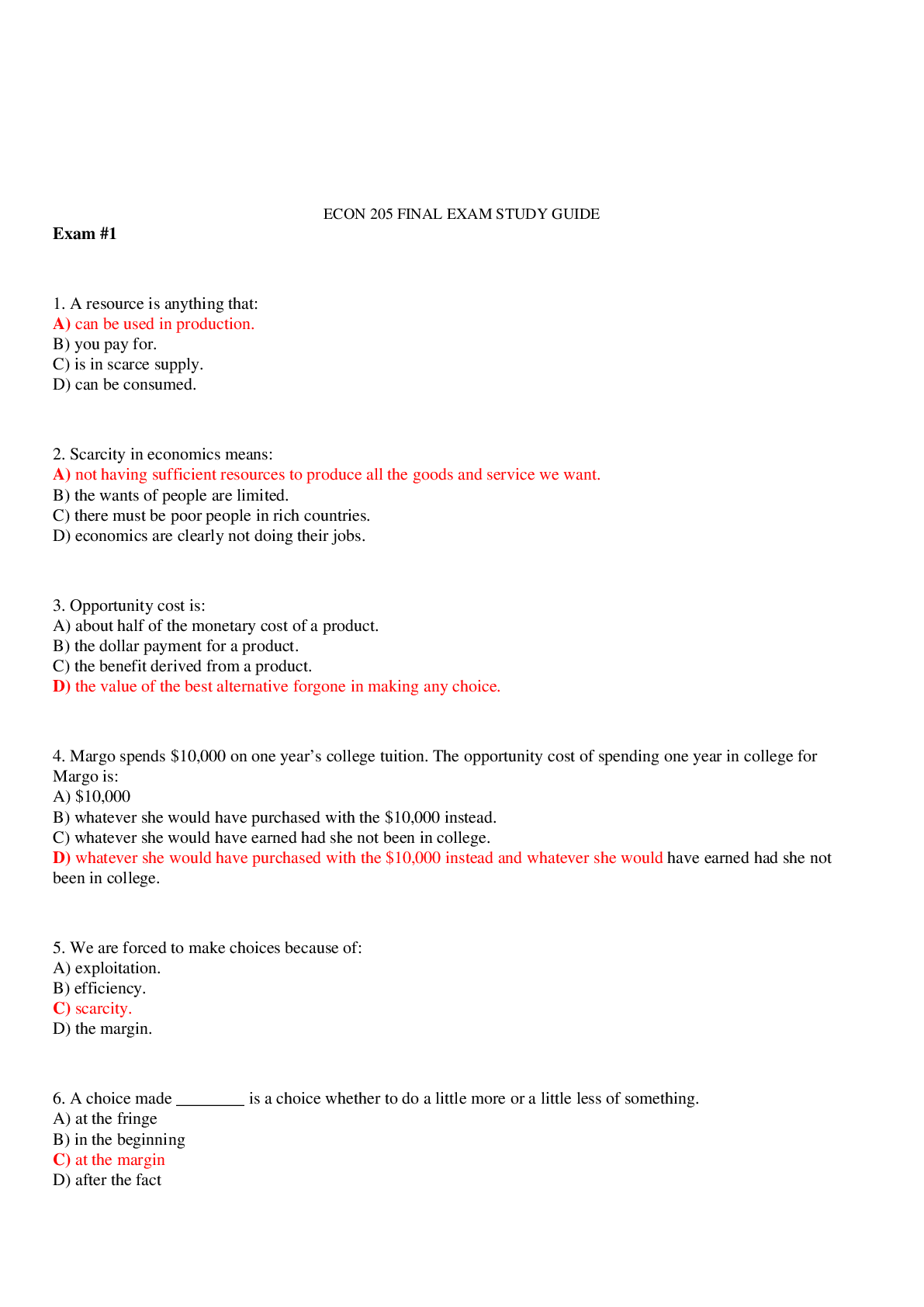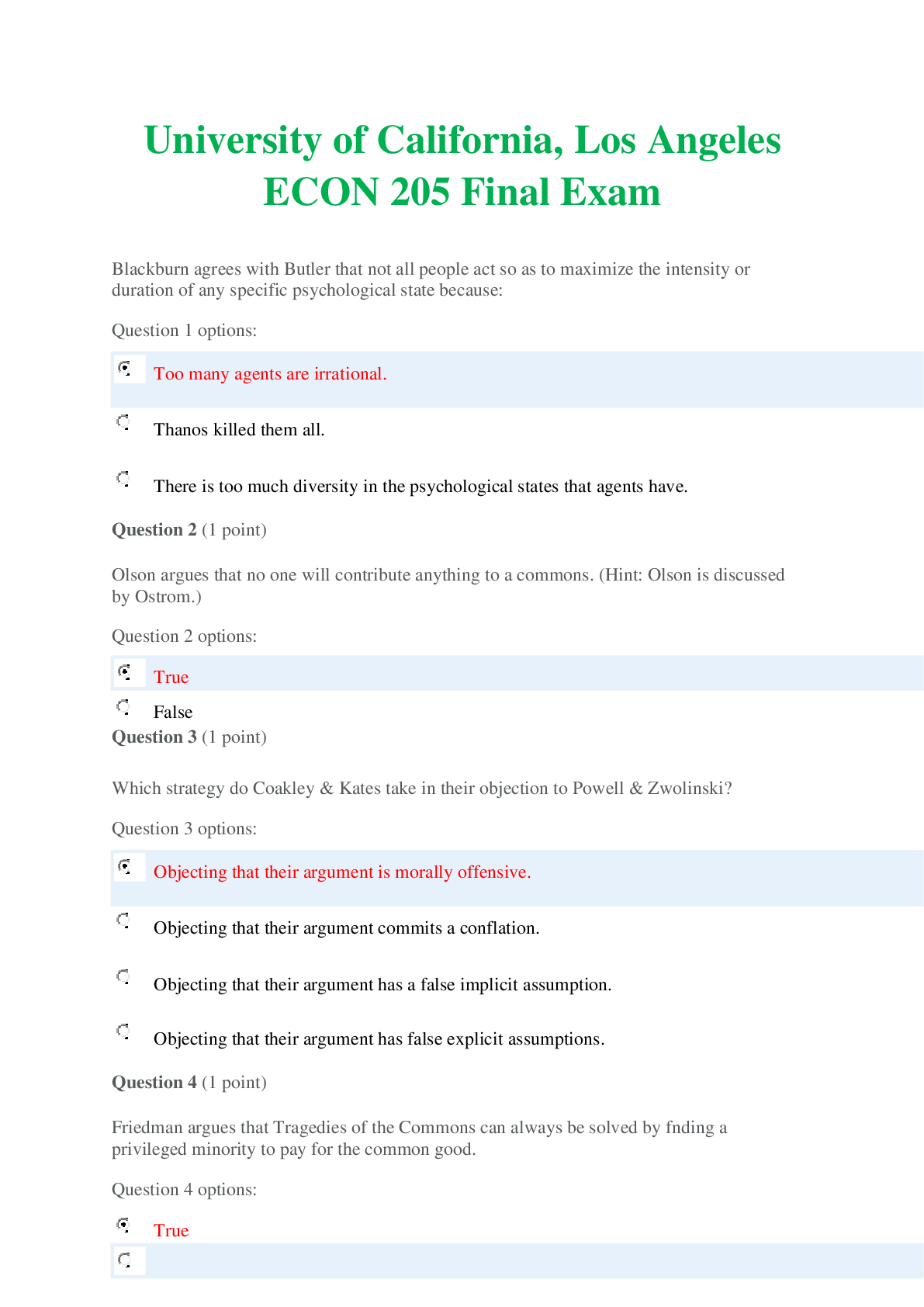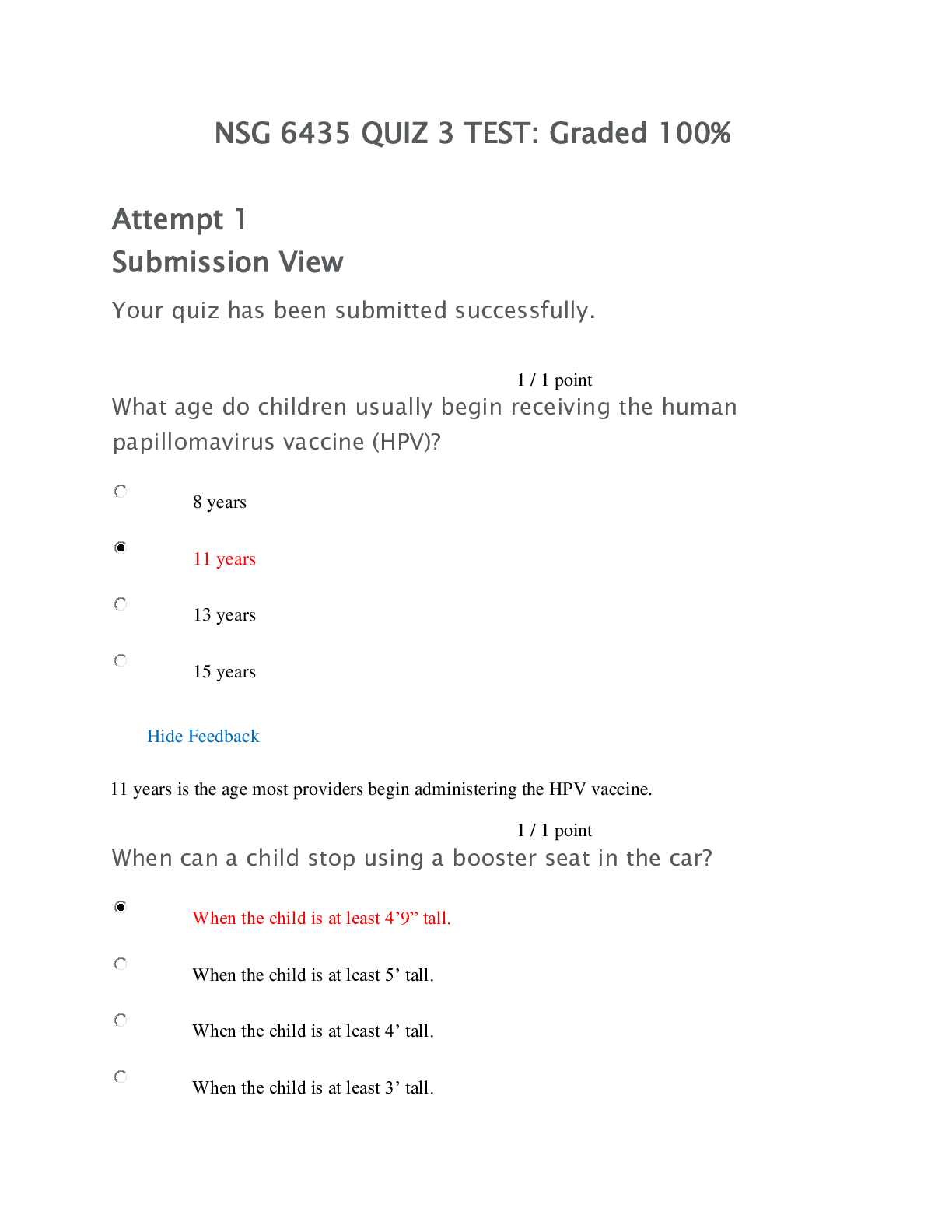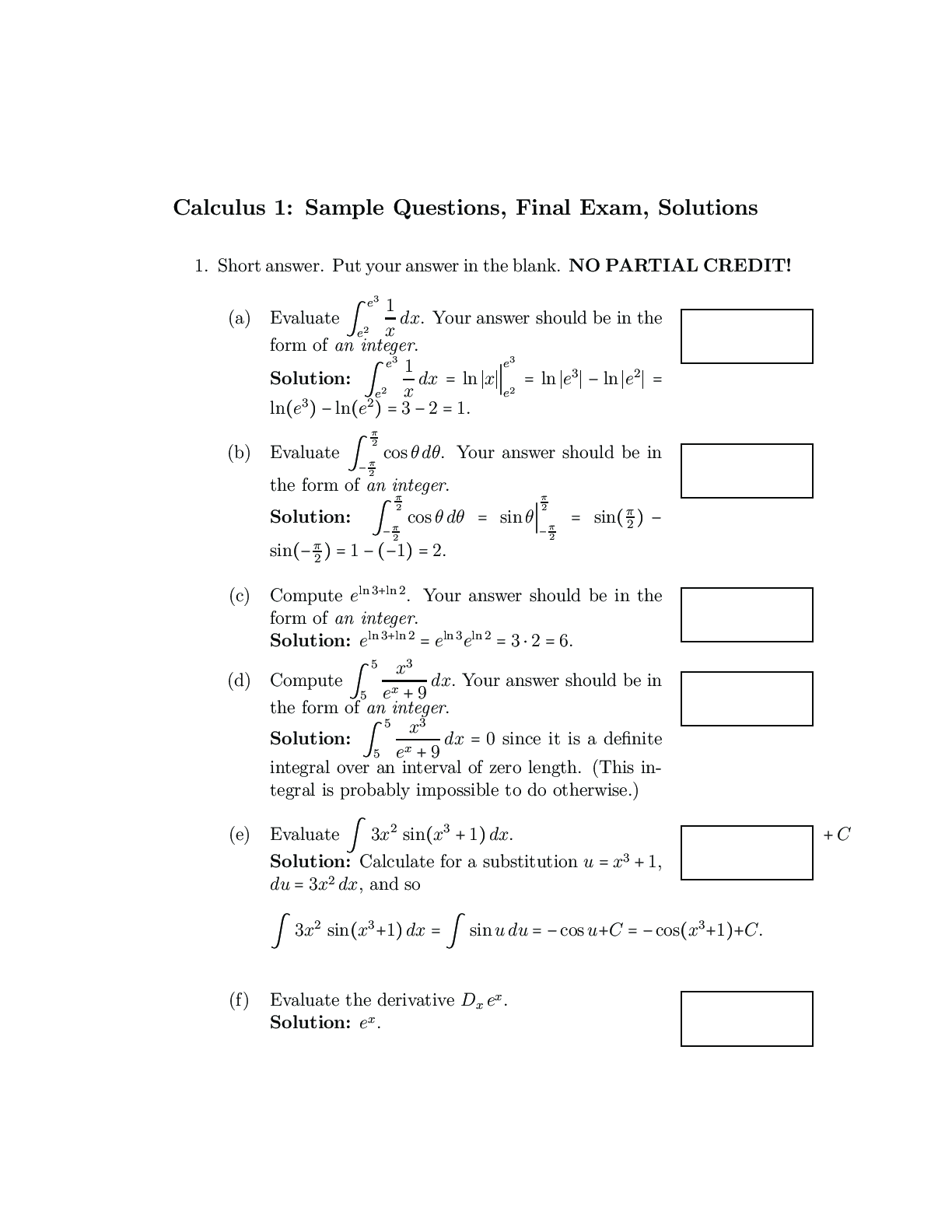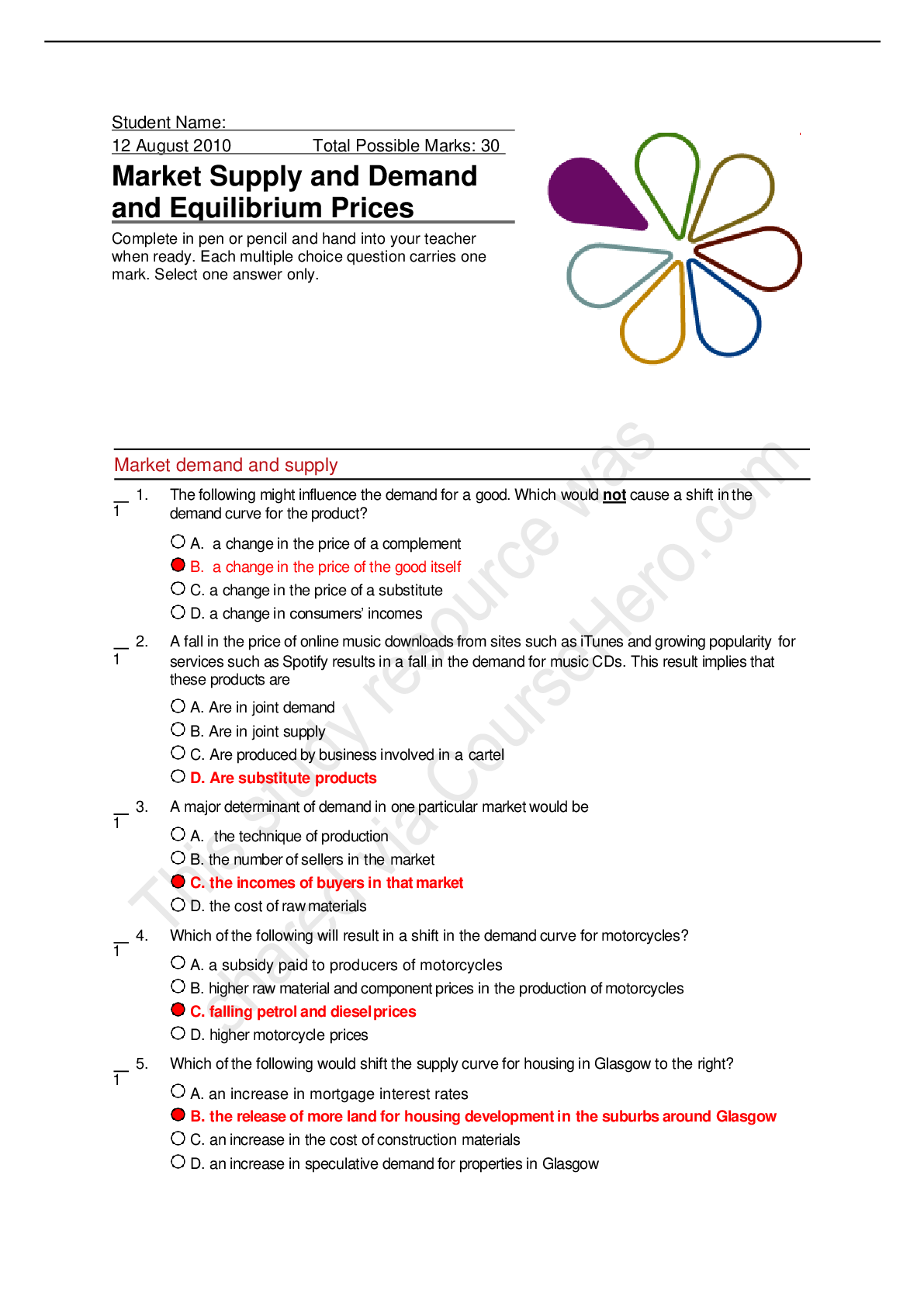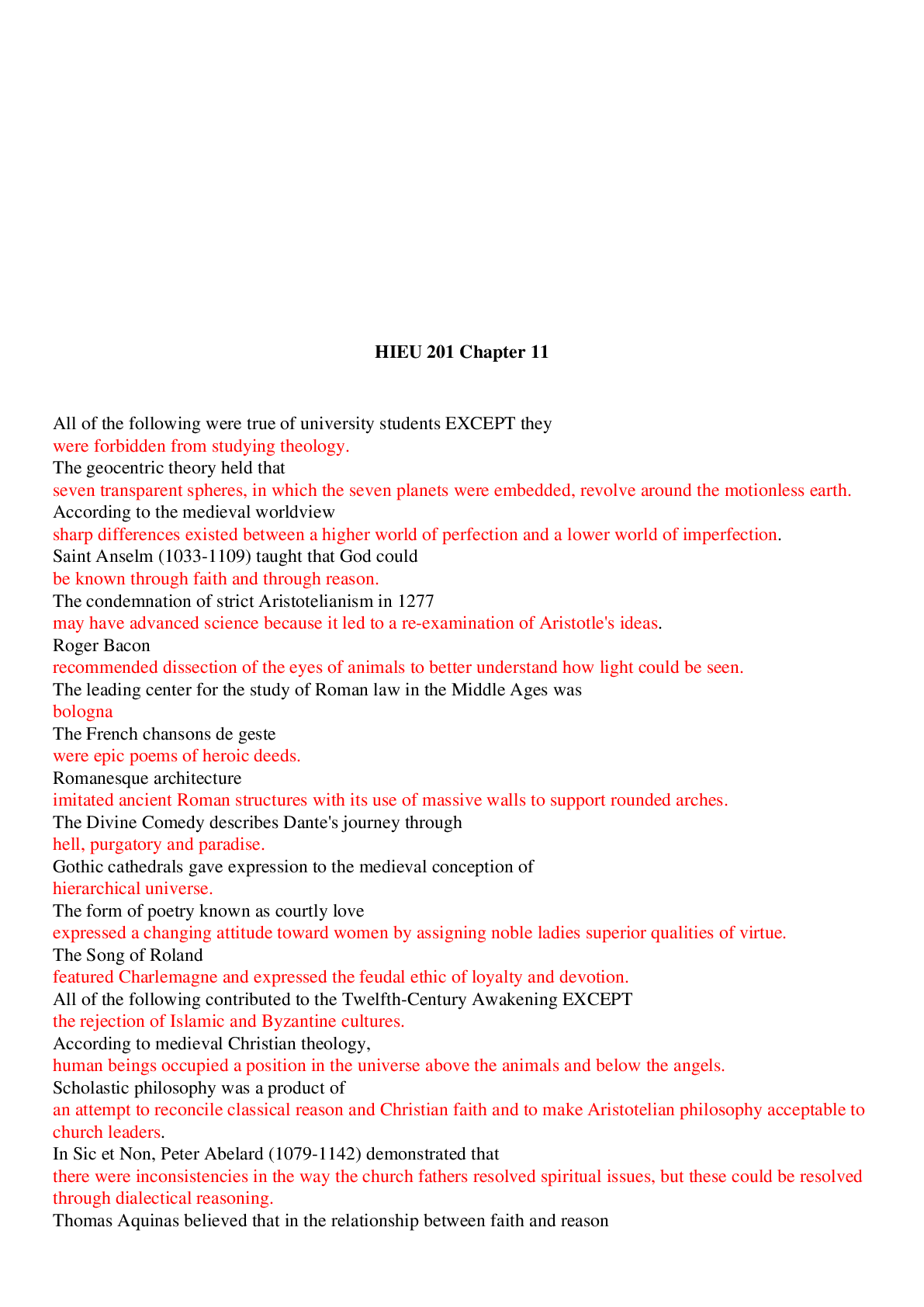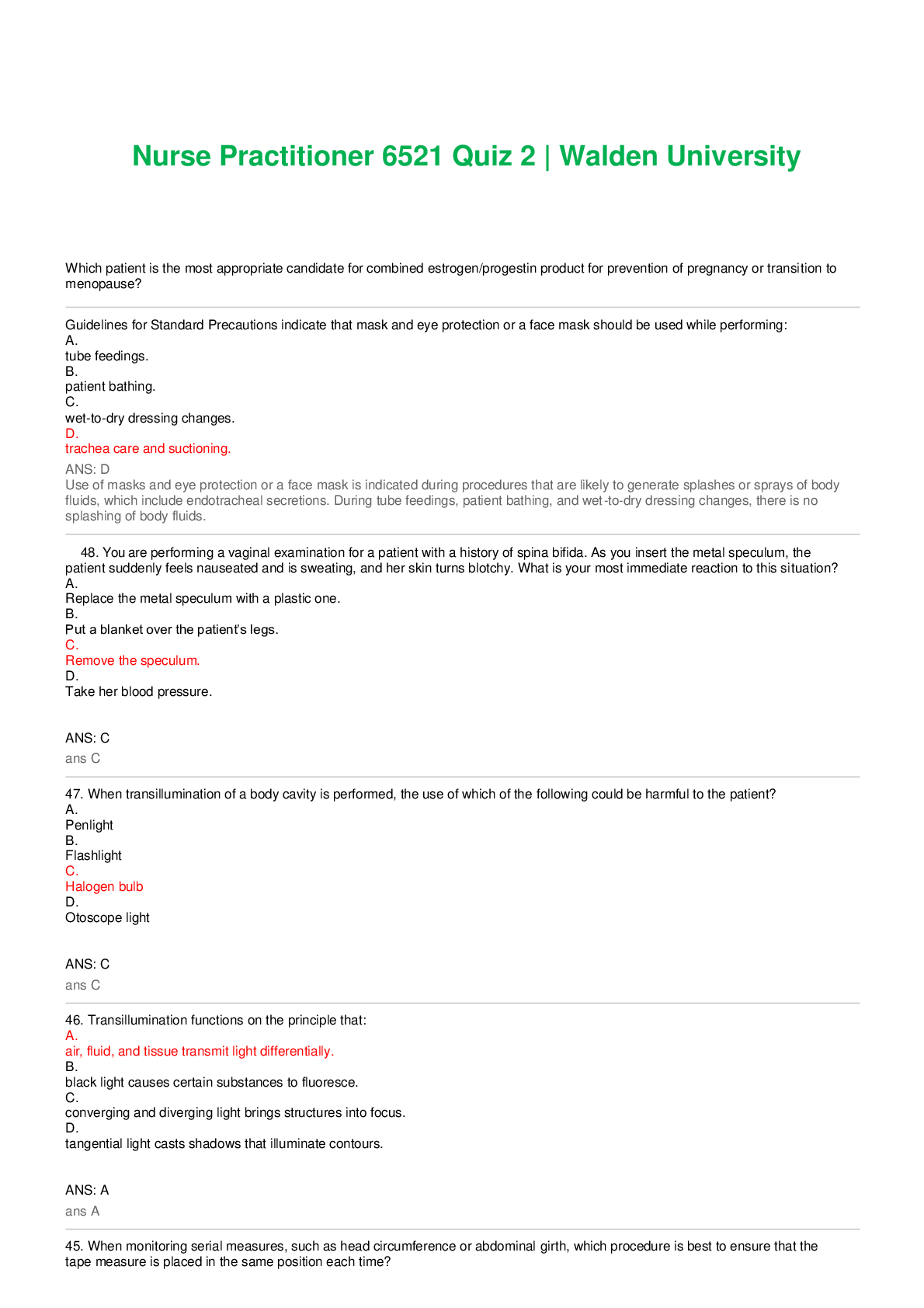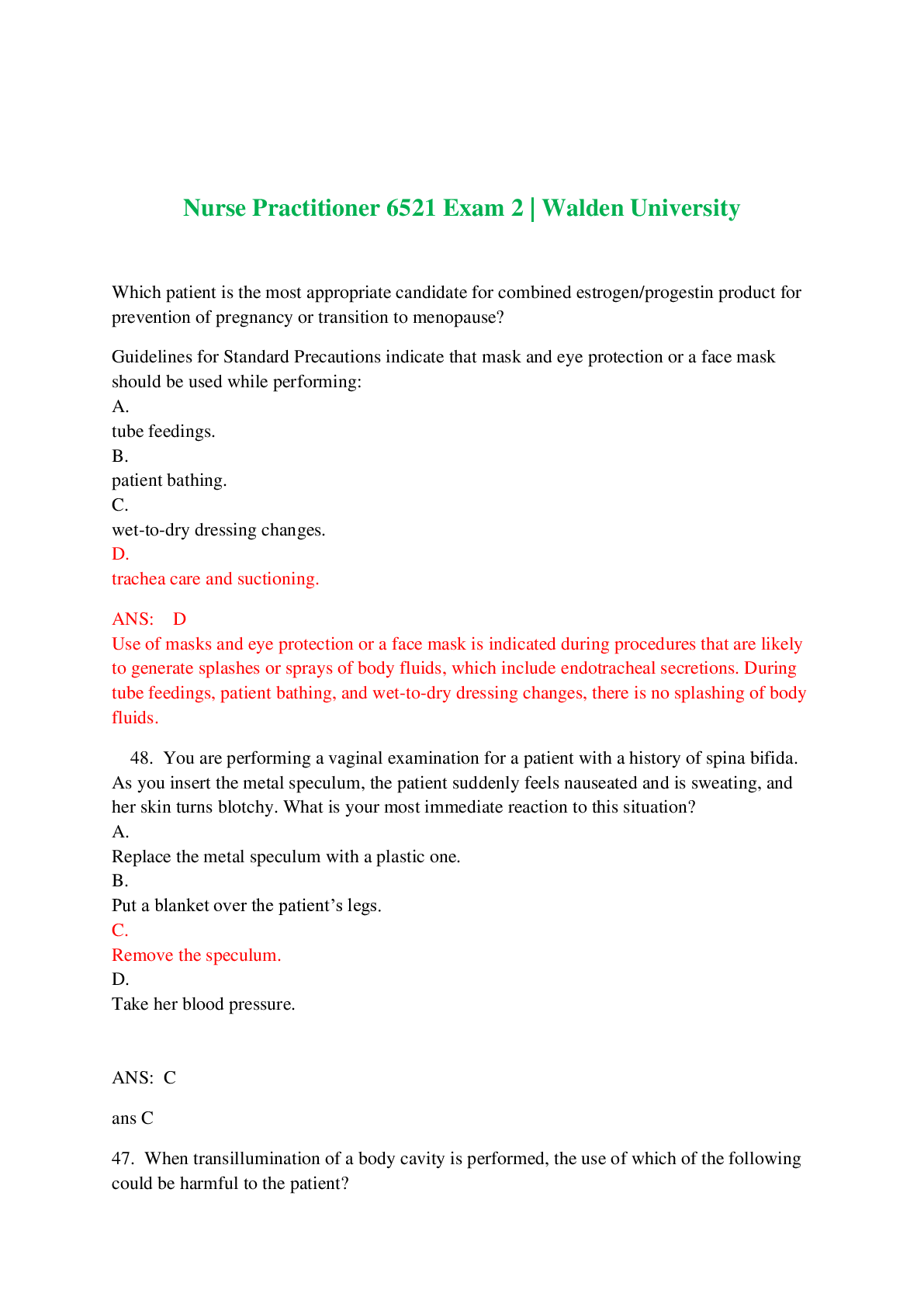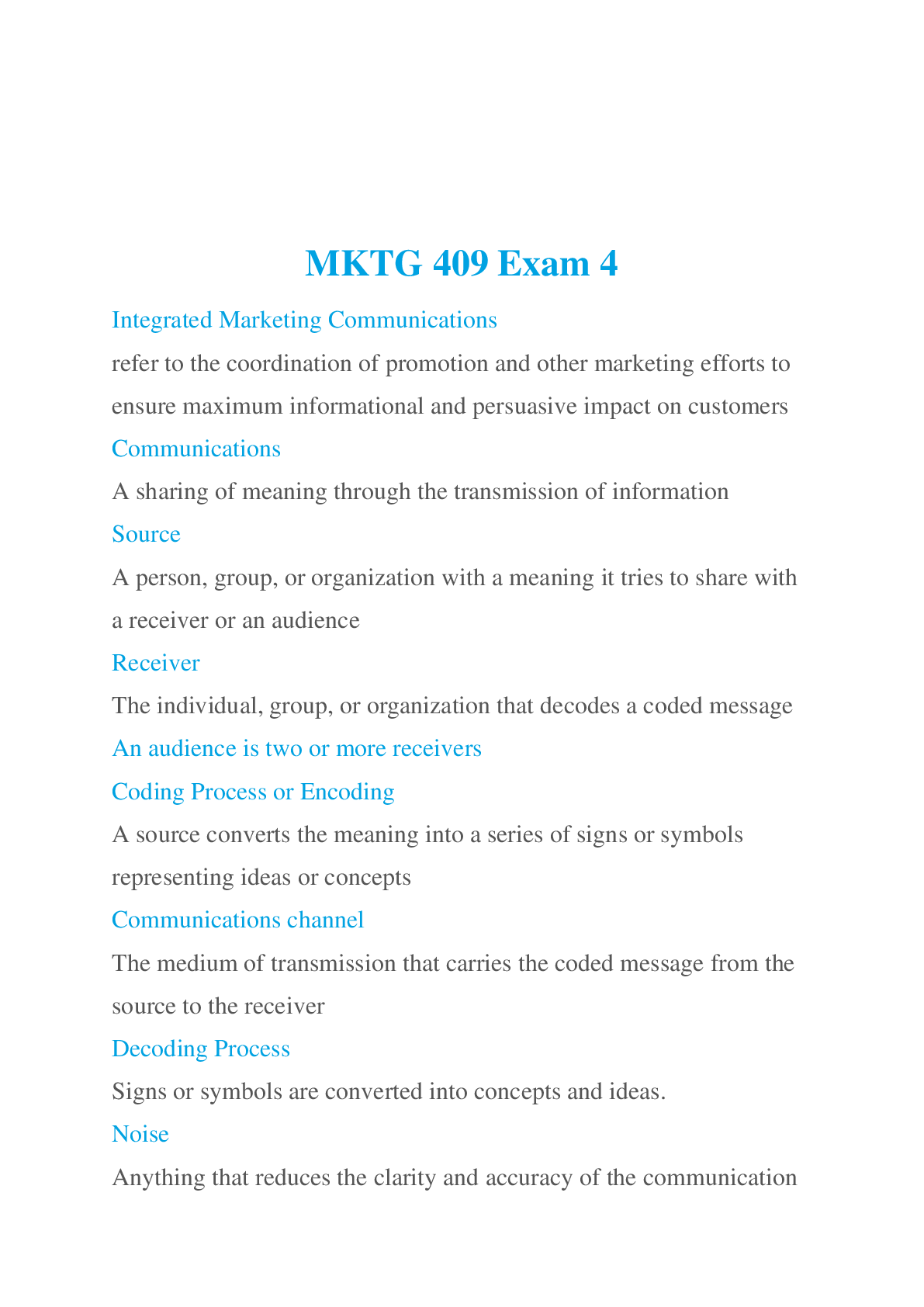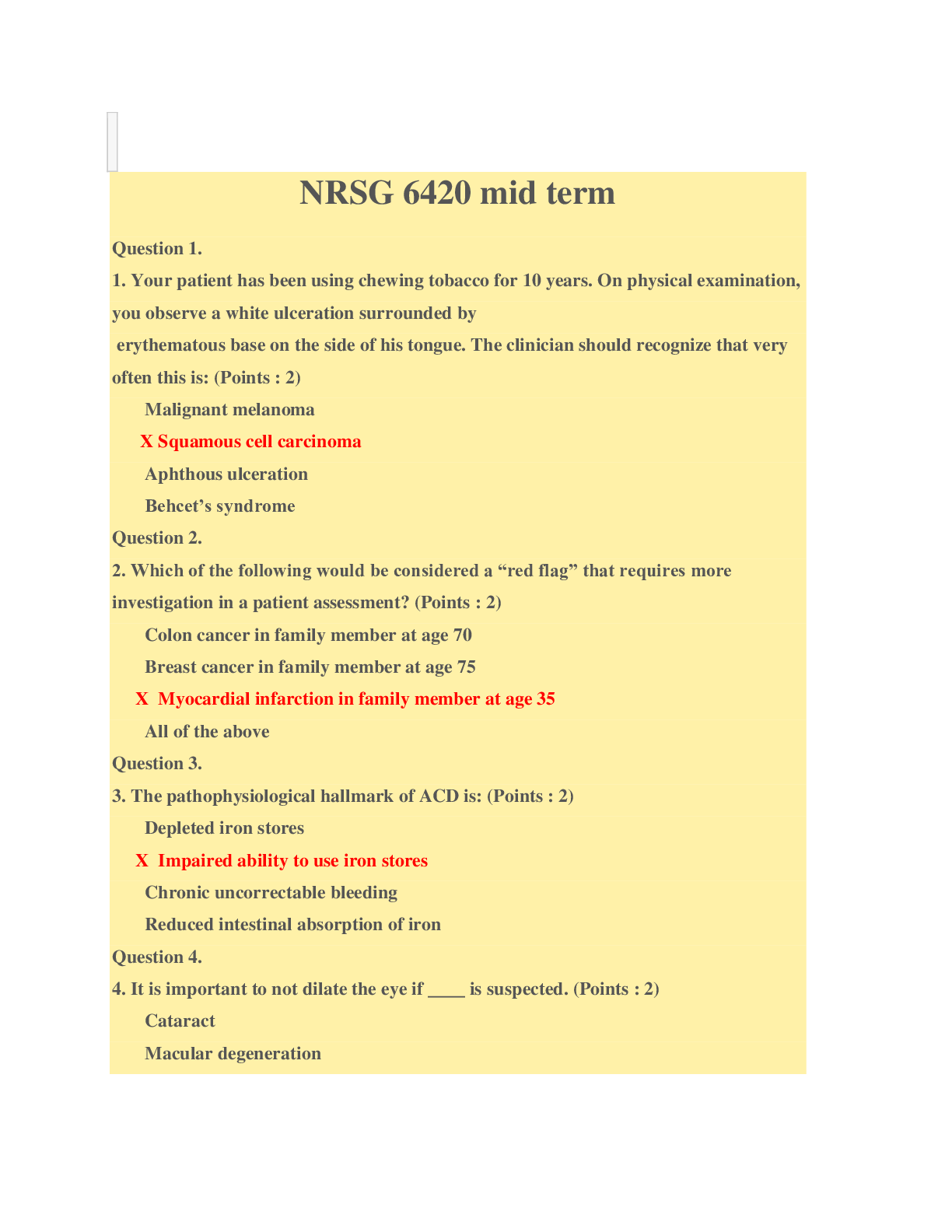USW1_NURS_5052_courseSchedule/ COMPLETE SOLUTION
Document Content and Description Below
NURS 5052/NURS 6052: Essentials of Evidence-Based Practice This Course Schedule outlines the assignments and due dates for the course. For full assignment details and directions, refer to the corre... sponding area in the course. Week 1 Overview of Evidence-Based Practice Resources Required Readings • Polit, D. F., & Beck, C. T. (2017). Nursing research: Generating and assessing evidence for nursing practice (10th ed.). Philadelphia, PA: Wolters Kluwer. o Chapter 1, “Introduction to Nursing Research in an Evidence-Based Practice Environment” o Chapter 2, “Evidence-Based Nursing: Translating Research Evidence into Practice” o Chapter 3, “Key Concepts and Steps in Qualitative and Quantitative Research” • Adams, J. S. (2010). Utilizing evidence-based research and practice to support the infusion alliance. Journal of Infusion Nursing, 33(5), 273–277. • Mallory, G. A. (2010). Professional nursing societies and evidence-based practice: Strategies to cross the quality chasm. Nursing Outlook, 58(6), 279–286. • Newhouse, R. P., & Spring, B. (2010). Interdisciplinary evidence-based practice: Moving from silos to synergy. Nursing Outlook, 58(6), 309–317. • Shaheen, M., Foo, S., Luyt, B., Zhang, X., Theng, Y-L., Chang, Y-K., & Mokhtar, I. A. (2011). Adopting evidence-based practice in clinical decision making: Nurses' perceptions, knowledge, and barriers. Journal of the Medical Library Association, 99(3), 229–236. Week 1 Overview of Evidence-Based Practice • Shivnan, J. C. (2011). How do you support your staff? Promote EBP. Nursing Management, 42(2), 12–14. • Walden Student Center for Success. (2012). Clinical Question Anatomy. Retrieved July 9, 2014, from http://academicguides.waldenu.edu/content.php?pid=183871& sid=2950360 Required Media • Laureate Education, Inc. (Executive Producer). (2012j). Timeline of nursing research. Baltimore, MD: Author. Discussion Nursing Research and Evidence-Based Practice By Day 3 Post an evaluation of the use, or lack thereof, of EBP in a recent clinical experience. Identify which aspects of the care delivered, if any, were based on evidence and provide your rationale. List your background question and PICOT question about this nursing topic. Critique how the policies, procedures, and culture in your organization may hinder or support the adoption of evidence-based practices. Identify the barrier you selected from the article and explain how this barrier could be overcome within your organization. Read a selection of your colleagues’ responses. By Day 6 Respond to at least two of your colleagues on two different days. Refer to the Week 1 Discussion area for details. Week 2 Finding Sources of Evidence Resources Required Readings • Academic Guides: Keyword Searching: Finding Articles on Your Topic: Boolean. (n.d.). Retrieved August 31, 2017, from http://academicguides.waldenu.edu/library/keyword/boolean • Academic Guides: Keyword Searching: Finding Articles on Week 2 Finding Sources of Evidence Your Topic: Searching Basics. (n.d.). Retrieved August 31, 2017, from http://academicguides.waldenu.edu/library/keyword/searching- basics • Polit, D. F., & Beck, C. T. (2017). Nursing research: Generating and assessing evidence for nursing practice (10th ed.). Philadelphia, PA: Wolters Kluwer. o Chapter 2, “Evidence-Based Nursing: Translating Research Evidence into Practice” (Review pages 27– 34) o Chapter 5, “Literature Reviews: Finding and Critiquing Evidence” • Houde, S. C. (2009). The systematic review of literature: A tool for evidence-based policy. Journal of Gerontological Nursing, 35(9), 9–12. • Krainovich-Miller, B., Haber, J., Yost, J., & Jacobs, S. K. (2009). Evidence-based practice challenge: Teaching critical appraisal of systematic reviews and clinical practice guidelines to graduate students. Journal of Nursing Education, 48(4), 186–195. • Robeson, P., Dobbins, M., DeCorby, K., & Tirilis, D. (2010). Facilitating access to pre-processed research evidence in public health. BMC Public Health, 10, 95. • Davies, K. S. (2011). Formulating the evidence based practice question: A review of the frameworks. Evidence Based Library and Information Practice, 6(2), 75–80. Retrieved from https://ejournals.library.ualberta.ca/index.php/EBLIP/article/vie wFile/9741/8144 • Search/Browse Help - Boolean Operators and Nesting. (n.d.). Retrieved August 31, 2017, from https://catalog.loc.gov/vwebv/ui/en_US/htdocs/help/searchBool ean.html • Walden University Library. (2012). Levels of evidence. Retrieved from http://academicguides.waldenu.edu/c.php?g=80240&p=52322 5 Week 2 Finding Sources of Evidence • Walden University. (n.d.b.). Searching and retrieving materials in the research databases. Retrieved August 10, 2012, from http://academicguides.waldenu.edu/foundationscoursedocs/Se archingRetrieving • Document: Course Project Overview (Word document) Required Media • Laureate Education, Inc. (Executive Producer). (2012e). Finding resources for EBP. Baltimore, MD: Author. • Laureate Education, Inc. (Executive Producer). (2012f). Finding sources of evidence. Baltimore, MD: Author. • Laureate Education, Inc. (Executive Producer). (2012g). Hierarchy of evidence pyramid. Baltimore, MD: Author. Discussion Literature Searches By Day 3 Post a summary of your search. Describe what topic you selected, the search term(s) that you used, and the number of results found at each level of the hierarchy. Compare the types of information found in the articles from different levels and the value of the information from each level. Highlight a useful tip that you could share with your colleagues about conducting an effective literature search. Read a selection of your colleagues’ responses. By Day 6 Respond to at least two of your colleagues on two different days. Refer to the Week 2 Discussion area for details. Project Course Project: Introduction to Course Project For the Course Project, you identify and apply relevant research to a specific nursing topic or problem. You begin by formulating an answerable question that is relevant to nursing and evidence-based Week 2 Finding Sources of Evidence practice. In later weeks of this course, you continue the Course Project by conducting a literature review and then determining how the evidence from the literature can be applied to nursing practice. Before you begin, review the Course Project Overview document located in this week’s Learning Resources. Note: This Course Project will serve as the Portfolio Assignment for the course. In addition to submitting portions of this Project in Weeks 2 and 5, you will turn in all three deliverables in Week 10. Course Project: Part 1—Identifying a Researchable Problem Write a 3- to 4-page paper that includes the following: • A summary of your area of interest, an identification of the problem that you have selected, and an explanation of the significance of this problem for nursing practice • The 5 questions that you have generated, and a description of how you analyzed them for feasibility • Your preliminary PICOT question and a description of each PICOT variable relevant to your question • At least 10 possible keywords that could be used when conducting a literature search for your PICOT question and a rationale for your selections By Day 7 This Project Assignment is due. It will also be a component of your Portfolio Assignment for this course, which is due by Day 7 of Week 10. Refer to the Week 2 Project area for details. Week 3 The Role of Theoretical Frameworks in Research Resources Required Readings • Polit, D. F., & Beck, C. T. (2017). Nursing research: Generating and assessing evidence for nursing practice (10th ed.). Philadelphia, PA: Wolters Kluwer. o Chapter 2, “Evidence-Based Nursing: Translating Research Evidence into Practice” (Review pages 14-31) Week 3 The Role of Theoretical Frameworks in Research o Chapter 6, “Theoretical Frameworks” • Cantrell, M. A. (2011). Demystifying the research process: Understanding a descriptive comparative research design. Pediatric Nursing, 37(4), 188–189. • Finn, P. (2011). Critical thinking: Knowledge and skills for evidence-based practice. Language, Speech, and Hearing Services in Schools, 42(1), 69–72. • Tagney, J., & Haines, C. (2009). Using evidence-based practice to address gaps in nursing knowledge. British Journal of Nursing (BJN), 18(8), 484–489. Required Media • Laureate Education, Inc. (Executive Producer). (2012i). Selecting a framework. Baltimore, MD: Author. Discussion Theory, Research, and Evidence-Based Practice By Day 3 Post a summary of the article that you located and explain how the theory or model that you selected was used in the research study. Assess the value of basing research on an established theory or model. Read a selection of your colleagues’ responses. By Day 6 Respond to at least two of your colleagues on two different days. Refer to the Week 3 Discussion area for details. Week 4 Nursing Research for Evidence-Based Practice Resources Required Readings • Polit, D. F., & Beck, C. T. (2017). Nursing research: Generating and assessing evidence for nursing practice (10th ed.). Philadelphia, PA: Wolters Kluwer. Week 4 Nursing Research for Evidence-Based Practice o Chapter 3, “Key Concepts and Steps in Qualitative and Quantitative Research” (for review) o Chapter 4, “Research Problems, Research Questions, and Hypotheses” o Chapter 7, “Ethics in Nursing Research” • Fouka, G., & Mantzorou, M. (2011). What are the major ethical issues in conducting research? Is there a conflict between the research ethics and the nature of nursing? Health Science Journal, 5(1), 3–14. • Newcomb, P. (2010). Evolving fairness in research on human subjects. Journal of Child and Adolescent Psychiatric Nursing, 23(3), 123–124. • Yakov, G., Shilo, Y., & Shor, T. (2010). Nurses’ perceptions of ethical issues related to patients' rights law. Nursing Ethics, 17(4), 501–510. • Delwiche, F. (2008). Anatomy of a scholarly research article in the health sciences. Retrieved from http://dana.uvm.edu/Anatomy/ • American Nurses Association. (2001). Code of ethics for nurses with interpretive statements. Retrieved from http://www.nursingworld.org/DocumentVault/Ethics_1/Code-of- Ethics-for-Nurses.html • Document: Literature Review Summary Table Template (Word document) Required Media • Laureate Education, Inc. (Executive Producer). (2012a). Anatomy of a research study. Baltimore, MD: Author. • Laureate Education, Inc. (Executive Producer). (2012d). Evidence-based practice and research. Baltimore, MD: Author. • Laureate Education, Inc. (Executive Producer). (2012h). Overview of evidence-based practice. Baltimore, MD: Author. Week 4 Nursing Research for Evidence-Based Practice Discussion Ethical Dimensions of Research Studies By Day 3 Post a description of the case that you selected and the ethical issues involved. Analyze the ethical principles that were breached by the researchers or organizations in your selected case as well as the possible cause of the breach(es). Suggest how the research might have been conducted differently to avoid or minimize the ethical problems. Discuss how research can be done on sensitive issues while still protecting the rights of the research subjects. Read a selection of your colleagues’ responses. By Day 6 Respond to at least two of your colleagues on two different days. Refer to the Week 2 Discussion area for details. Project Course Project: Part 2—Literature Review This is a continuation of the Course Project presented in Week 2. Before you begin, review the Course Project Overview document located in the Week 2 Resources area. Write a 3-to 4-page literature review that includes the following: • A synthesis of what the studies reveal about the current state of knowledge on the question that you developed o Point out inconsistencies and contradictions in the literature and offer possible explanations for inconsistencies. • Preliminary conclusions on whether the evidence provides strong support for a change in practice or whether further research is needed to adequately address your inquiry • Your literature review summary table with all references formatted in correct APA style This part of the Course Project is due by Day 7 of Week 5. It will also be a component in your Portfolio Assignment in this course, which is due by Day 7 of Week 10. Refer to the Week 4 Project area for details. Week 4 Nursing Research for Evidence-Based Practice Week 5 Quantitative Research Designs—Part 1 Resources Required Readings • Polit, D. F., & Beck, C. T. (2017). Nursing research: Generating and assessing evidence for nursing practice (10th ed.). Philadelphia, PA: Wolters Kluwer. o Chapter 8, “Planning a Nursing Study” o Chapter 9, “Quantitative Research Design” Required Media • Laureate Education, Inc. (Executive Producer). (2012m). Quantitative research for evidence-based practice. Baltimore, MD: Author. Discussion Quantitative Research Designs By Day 3 Post the topic that you selected, references for the two sources you identified, and the quantitative research design used in each. Critique the appropriateness of the design used and justify your comments with information from the Learning Resources. Discuss the ramifications of choosing an inappropriate design for a research study. Read a selection of your colleagues’ responses. By Day 6 Respond to at least two of your colleagues on two different days. Refer to the Week 5 Discussion area for details. Project Course Project: Part 2—Literature Review The Project Assignment, Part 2—Literature Review, which you began working on in Week 4, is due by Day 7. It will also be a component in your Course Project due by Day 7 of Week 10. Week 6 Quantitative Research Designs—Part 2 Resources Required Readings • Polit, D. F., & Beck, C. T. (2017). Nursing research: Generating and assessing evidence for nursing practice (10th ed.). Philadelphia, PA: Wolters Kluwer. o Chapter 10, “Rigor and Validity in Quantitative Research” o Chapter 11, “Specific Types of Quantitative Research” • Cantrell, M. A. (2011). Demystifying the research process: Understanding a descriptive comparative research design. Pediatric Nursing, 37(4), 188–189. (for review) • Schultz, L. E., Rivers, K. O., & Ratusnik, D. L. (2008). The role of external validity in evidence-based practice for rehabilitation. Rehabilitation Psychology, 53(3), 294–302. Note: For the Discussion this week, you will need to read the method section of one of the following quasi-experimental studies. Refer to the details provided in the Week 6 Discussion area. • Metheny, N. A., Davis-Jackson, J., & Stewart, B. J. (2010). Effectiveness of an aspiration risk-reduction protocol. Nursing Research, 59(1), 18–25. • Padula, C. A., Hughes, C., & Baumhover, L. (2009). Impact of a nurse-driven mobility protocol on functional decline in hospitalized older adults. Journal of Nursing Care Quality, 24(4), 325–331. • Yuan, S.-C., Chou, M.-C., Hwu, L.-J., Chang, Y.-O., Hsu, W.- H., & Kuo, H.-W. (2009). An intervention program to promote health-related physical fitness in nurses. Journal of Clinical Nursing, 18(10), 1,404–1,411. • Walden University. (n.d.a). Retrieved July 23, 2012, from http://writingcenter.waldenu.edu/57.htm • Document: Critique Template for a Qualitative Study (Word document) • Document: Critique Template for a Quantitative Study (Word document) Week 6 Quantitative Research Designs—Part 2 • Document: Critique Template for a Mixed-Methods Study (Word document) Discussion Validity in Quantitative Research Designs By Day 3 Post the title of the study that you selected and your analysis of the potential concerns that could be raised about the study’s internal validity. Propose recommendations to strengthen the internal validity and assess the effect your changes could have with regard to the other three types of validity. Discuss the dangers of failing to consider the validity of a research study. Read a selection of your colleagues’ responses. By Day 6 Respond to at least two of your colleagues. Refer to the Week 6 Discussion area for details. Assignment Application: Critiquing Quantitative, Qualitative, or Mixed Methods Studies • Complete the two critiques using the appropriate templates. • Write a 2- to 3-page paper that addresses the following: o Contrast the types of information that you gained from examining the two different research approaches in the articles that you selected. o Describe the general advantages and disadvantages of the two research approaches featured in the articles. Use examples from the articles for support. o Formulate a response to the claim that qualitative research is not real science. Highlight the general insights that both quantitative and qualitative studies can provide to researchers. Support your response with references to the Learning Resources and other credible sources. As you complete this Assignment, remember to: • Submit your paper to Grammarly and SafeAssign through the Walden Writing Center. Based on the Grammarly and SafeAssign reports, revise your paper as necessary. Week 6 Quantitative Research Designs—Part 2 • Reminder: The School of Nursing requires that all papers submitted include a title page, introduction, summary, and references. The School of Nursing Sample Paper provided at the Walden Writing Center provides an example of those required elements (available from the Walden University website found in this week’s Learning Resources). All papers submitted must use this formatting. • Combine all three parts of this assignment into one Word document including both critique templates and the narrative with your references. Submit this combined document. By Day 7 of Week 7 This Assignment is due. Refer to the Week 6 Assignment area for details. Week 7 Qualitative And Mixed Methods Research Designs Resources Required Readings • Polit, D. F., & Beck, C. T. (2017). Nursing research: Generating and assessing evidence for nursing practice (10th ed.). Philadelphia, PA: Wolters Kluwer. o Chapter 21, “Qualitative Research Design and Approaches” • Houghton, C. E., Casey, D., Shaw, D., & Murphy, K. (2010). Ethical challenges in qualitative research: Examples from practice. Nurse Researcher, 18(1), 15–25. • Pringle, J., Hendry, C., & McLafferty, E. (2011). Phenomenological approaches: Challenges and choices. Nurse Researcher, 18(2), 7–18. • Ryan-Nicholls, K. D., & Will, C. I. (2009). Rigour in qualitative research: Mechanisms for control. Nurse Researcher, 16(3), 70–85. • Smith, J., Bekker, H., & Cheater, F. (2011). Theoretical versus pragmatic design in qualitative research. Nurse Researcher, 18(2), 39–51. Week 7 Qualitative And Mixed Methods Research Designs • Walker, W. (2011). Hermeneutic inquiry: Insights into the process of interviewing. Nurse Researcher, 18(2), 19–27. • Williamson, K. M. (2009). Evidence-based practice: Critical appraisal of qualitative evidence. Journal of the American Psychiatric Nurses Association, 15(3), 202–207. • Wuest, J. (2011). Are we there yet? Positioning qualitative research differently. Qualitative Health Research, 21(7), 875– 883. Required Media • Laureate Education, Inc. (Executive Producer). (2012l). Qualitative and mixed methods research designs. Baltimore, MD: Author. Discussion Qualitative Research Designs By Day 3 Post an APA citation for the article that you selected and provide a brief summary of the content and the qualitative research design used. Evaluate the appropriateness of the design, and explain how ethical issues in the study were addressed. Analyze how the study would have been different if a quantitative design had been used. Read a selection of your colleagues’ responses. By Day 6 Respond to at least two of your colleagues on two different days. Refer to the Week 7 Discussion area for details. Assignment Application: Critiquing Quantitative, Qualitative, or Mixed Methods Studies By Day 7 The Assignment, Critiquing Quantitative, Qualitative, or Mixed Methods Studies, which you began working on in Week 6, is due. Week 8 Data Collection Resources Required Readings • Polit, D. F., & Beck, C. T. (2017). Nursing research: Generating and assessing evidence for nursing practice (10th ed.). Philadelphia, PA: Wolters Kluwer. o Chapter 12, “Sampling in Quantitative Research” o Chapter 13, “Data Collection in Quantitative Research” o Chapter 22, “Sampling in Qualitative Research” o Chapter 23, “Data Collection in Qualitative Research” • Keough, V. A., & Tanabe, P. (2011). Survey research: An effective design for conducting nursing research. Journal of Nursing Regulation, 1(4), 37–44. • Walden University. (n.d.a). Paper templates. Retrieved July 23, 2012, from http://writingcenter.waldenu.edu/57.htm Required Media • Laureate Education, Inc. (Executive Producer). (2012b). Data collection. Baltimore, MD: Author. Discussion Planning for Data Collection By Day 3 Post the questions that you created for gathering information about patient satisfaction based on the above scenario. Explain which method or instrument you would use to gather data. Describe the sample size appropriate for the population and how you would select participants. Provide a rationale for your choices, and explain how you can ensure high standard of reliability and validity. Read a selection of your colleagues’ responses. By Day 6 Respond to at least two of your colleagues on two different days. Refer to the Week 8 Discussion area for details. Project Course Project: Part 3—Translating Evidence Into Practice In a 3- to 4-page paper: Week 8 Data Collection • Restate your PICOT question and its significance to nursing practice. • Summarize the findings from the articles that you selected for your literature review. Describe at least one nursing practice that is supported by the evidence in the articles. Justify your response with specific references to at least 2 of the articles. • Explain how the evidence-based practice that you identified contributes to better outcomes. In addition, identify potential negative outcomes that could result from failing to use the evidence-based practice. • Outline the strategy for disseminating the evidence-based practice that you identified throughout your practice setting. Explain how you would communicate the importance of the practice to your colleagues. Describe how you would move from disseminating the information to implementing the evidence-based practice within your organization. How would you address concerns and opposition to the change in practice? This part of the Course Project is due by Day 7 of Week 10. It should be combined with the other two components of the Course Project and turned in as your Portfolio Assignment for this course. Note: In addition, include a 1-page summary of your project. For this final iteration, you will need to: • Submit your paper to Grammarly and SafeAssign through the Walden Writing Center. Based on the Grammarly and SafeAssign reports, revise your paper as necessary. • Reminder: The School of Nursing requires that all papers submitted include a title page, introduction, summary, and references. The School of Nursing Sample Paper provided at the Walden Writing Center provides an example of those required elements (available from the Walden University website found in this week’s Learning Resources). All papers submitted must use this formatting. Refer to the Week 8 Project area for details. Looking Ahead Next week, you will work in a small group for the Discussion as you prepare a study sheet for your colleagues. You will receive your group assignment and assigned reading by Day 1 of Week 9. Your Discussion posting will be due by Day 5 of Week 9. Week 8 Data Collection Week 9 Data Analysis Resources Required Readings • Polit, D. F., & Beck, C. T. (2017). Nursing research: Generating and assessing evidence for nursing practice (10th ed.). Philadelphia, PA: Wolters Kluwer. • For this week’s Discussion, you will be assigned to a group. Each group will be assigned one of the following chapters. You will only be responsible for reading your assigned chapter. The Instructor will notify you of your group and assigned chapter by Day 1 of this week. o Chapter 16, “Descriptive Statistics” o Chapter 17, “Inferential Statistics” o Chapter 18, “Multivariate Statistics” o Chapter 19, “Processes of Quantitative Data Analysis” o Chapter 24, “Qualitative Data Analysis” Discussion Data Analysis—Small Group Discussion By Day 5 Post your group’s study sheet. Discuss why it is important for nurses to understand the basics of these statistical methods. Read a selection of your colleagues’ responses. By Day 6 Respond to at least two of your colleagues on two different days. Refer to the Week 9 Discussion area for details. Week 10 Weighing the Evidence Resources Required Readings • Polit, D. F., & Beck, C. T. (2017). Nursing research: Generating and assessing evidence for nursing practice (10th Week 10 Weighing the Evidence ed.). Philadelphia, PA: Wolters Kluwer. o Review Chapter 2, Fig. 2.1 o Chapter 29, “Systematic Reviews of Research Evidence: Meta-analysis, Metasynthesis, and Mixed Studies Review” • Dingle, P. (2011). Statin statistics: Lies and deception. Positive Health, 180, 1. • Katapodi, M. C., & Northouse, L. L. (2011). Comparative effectiveness research: Using systematic reviews and meta- analyses to synthesize empirical evidence. Research & Theory for Nursing Practice, 25(3), 191–209. • Stichler, J. F. (2010). Evaluating the evidence in evidence- based design. Journal of Nursing Administration, 40(9), 348– 351. • Bernd, R., du Prel, J.-B., & Blettner, M. (2009). Study design in medical research: Part 2 of a series on the evaluation of scientific publications. Deutsches Aerzteblatt International, 106(11), 184–189. Retrieved from http://www.ncbi.nlm.nih.gov/pmc/articles/PMC2695375/pdf/Dts ch_Arztebl_Int-106-0184.pdf • Walden University. (n.d.a). Paper templates. Retrieved 23 July, 2012, from http://writingcenter.waldenu.edu/57.htm Required Media • Laureate Education, Inc. (Executive Producer). (2012g). Hierarchy of evidence pyramid. Baltimore, MD: Author. (Review) • Laureate Education, Inc. (Executive Producer). (2012n). Weighing the evidence. Baltimore, MD: Author. Discussion Weighing the Evidence By Day 3 Post an APA citation and brief summary of the research article that you selected. Describe the data and the results of any statistical tests or analyses presented in the article. Explain how the researchers Week 10 Weighing the Evidence formulated their conclusion, any weaknesses in their analysis or conclusions, and offer at least one alternate interpretation of their data. Propose at least one additional research study that could be done to further investigate this research topic. Read a selection of your colleagues’ responses. By Day 6 Respond to at least two of your colleagues on two different days. Refer to the Week 10 Discussion area for details. Project Course Project By Day 7 The Course Project is due. Reminder: You will combine Parts 1, 2, and 3 of your Course Project (assigned in Weeks 2, 4, and 8 respectively) into one cohesive and cogent paper. Note: In addition, include a 1-page summary of your project. Note: The Course Project will be your Portfolio Assignment for this course. Refer to the Week 10 Project area for details. Week 11 Translating Evidence Into Practice Resources Required Readings • Polit, D. F., & Beck, C. T. (2017). Nursing research: Generating and assessing evidence for nursing practice (10th ed.). Philadelphia, PA: Wolters Kluwer. o Chapter 30, “Disseminating Evidence: Reporting Research Findings” • Aitken, L. M., Hackwood, B, Crouch, S., Clayton, S., West, N., Carney, D., & Jack, L. (2011). Creating an environment to implement and sustain evidence based practice: A developmental process. Australian Critical Care, 24(4), 244– 254. Week 11 Translating Evidence Into Practice • Barnsteiner, J. H., Reeder, V. C., Palma, W. H., Preston, A. M., & Walton, M. K. (2010). Promoting evidence-based practice and translational research. Nursing Administration Quarterly, 34(3), 217–225. • Cullen, L., & Adams, S. L. (2012). Planning for implementation of evidence-based practice. Journal of Nursing Administration, 42(4), 222–230. • Estrada, N. (2009). Exploring perceptions of a learning organization by RNs and relationship to EBP beliefs and implementation in the acute care setting. Worldviews on Evidence-Based Nursing, 6(4), 200–209. • Fineout-Overholt, E., Williamson, K. M., Kent, B., & Hutchinson, A. M. (2010). Teaching EBP: Strategies for achieving sustainable organizational change toward evidence- based practice. Worldviews on Evidence-Based Nursing, 7(1), 51–53. • Munten, G. van den Bogaard, J., Cox, K., Garretsen, H., & Bongers, I. (2010). Implementation of evidence-based practice in nursing using action research: A review. Worldviews on Evidence-Based Nursing, 7(3), 135–157. • Satterfield, J. M., Spring, B., Brownson, R. C., Mullen, E. J., Newhouse, R. P., Walker, B. B., & Whitlock, E. P. (2009). Toward a transdisciplinary model of evidence-based practice. The Milbank Quarterly, 87(2), 368–390. • Steurer, L. M. (2010). An evidence-based practice scholars program: One institution's journey toward excellence. Journal of Continuing Education in Nursing, 41(3), 139–143. Required Media • Laureate Education, Inc. (Executive Producer). (2012k). Translating evidence into practice. Baltimore, MD: Author. • Laureate Education, Inc. (Executive Producer). (2012c). Disseminating findings. Baltimore, MD: Author. Discussion Creating a Culture of Evidence-Based Practice Week 11 Translating Evidence Into Practice By Day 3 Post an evaluation of your organization’s use of EBP and how it is furthered or hindered by organizational culture and policies. Describe how you could disseminate the findings. Propose a strategy for strengthening the culture of EBP within the organization. Discuss a nurse’s responsibility to further the use of EBP, providing a rationale supported by specific information from the Learning Resources. Read a selection of your colleagues’ responses. By Day 6 Respond to at least two of your colleagues on two different days. Refer to the Week 11 Discussion area for details. Course Evaluation Be sure to submit your course evaluation by Day 7. [Show More]
Last updated: 2 years ago
Preview 1 out of 20 pages
 (1).png)
Buy this document to get the full access instantly
Instant Download Access after purchase
Buy NowInstant download
We Accept:

Reviews( 0 )
$16.50
Can't find what you want? Try our AI powered Search
Document information
Connected school, study & course
About the document
Uploaded On
Jul 16, 2021
Number of pages
20
Written in
Additional information
This document has been written for:
Uploaded
Jul 16, 2021
Downloads
0
Views
49


